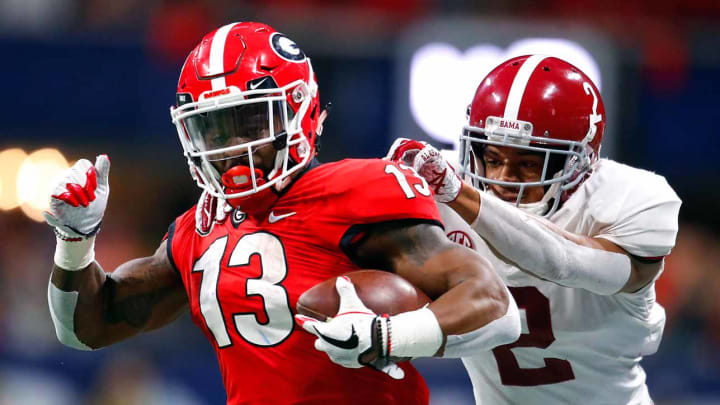Five College Stars Whose Bad Combine Numbers Shouldn't Be Cause for Panic

The weirdest week of the year in football, the NFL combine, is over, and everyone is leaving Indianapolis with a new set of strange questions not to ask prospects and the fresh memory of the standout performances that will be analyzed and cross-checked from every angle between now and the draft. But for every eye-popping number, there was a lackluster showing that raised eyebrows among those who saw the same prospects star at the college level. The players below turned in combines that disappointed in at least one facet, but scouts would do well to consider the body of work they put together in college before marking them down.
Elijah Holyfield, RB, Georgia
Holyfield left Georgia after his junior season, his first year of getting meaningful reps after playing behind Nick Chubb and Sony Michel. Last fall, he rushed for 1,018 yards, averaging 6.4 yards per carry with a punishing running style that evoked his famous father, former heavyweight champion Evander Holyfield. Instead, he ran a 4.76-second 40-yard dash, the second-slowest among running backs. No one expected Holyfield to be one of the fastest players in Indianapolis, but he’s also not big or bruising enough to justify that slow of a time.
The upside for Holyfield is that his 40s looked downright creaky; he wasn’t running with the explosiveness he did for most of the season. Between now and his pro day, he’ll need to focus on channeling the speed he’s displayed on gameday into his 40. But his strength (he put up 26 reps in the bench press) and his ability to shed weaker defenders should come to the forefront at a position where straight-line speed shouldn’t be one of the top three things that matters.
Benny Snell, RB, Kentucky
Snell, the workhorse at the center of Kentucky’s breakthrough season, was never going to set records in the 40, but with a 4.65, he was only just slightly faster than Holyfield. That shouldn’t crater his mid-round draft projection, but it also won’t vault him into any conversations about being a steal at that point, or push him into an earlier round. Concerns about Snell’s speed have dogged him since he was in high school, and he went on to be one of the best backs in Kentucky history, leaving a legacy of power and (perhaps more importantly) durability. No team who’s been looking at Snell should be too concerned by his time, and as long as he doesn’t run slower at his pro day, he should be just fine.
Jachai Polite, DL, Florida
Polite may have had one of the most disappointing combines of anyone. The former Florida edge terror showed up with some unnecessary added weight at 258 pounds and clocked a 4.84-second 40—surprisingly sluggish for a player who garnered attention in college with his burst and speed around the edge. (Last fall, SI’s Andy Staples chronicled Polite’s efforts to slim down to 245 in order to maximize his potential on the edge.) Polite’s 10-yard dash clocked in at an uninspiring 1.71 seconds, and if that wasn’t enough, he reportedly had a disastrous few days in the interview room, and scouts were under the impression that the hamstring injury he used as justification for dropping out of several drills was overblown.
All in all, Polite may have done enough wrong to drop himself out of the first round, barring a redemptive pro day. Polite’s biggest selling point might be his rawness, which a team might be able to harness with some hard work on both sides.
Lil’Jordan Humphrey, WR, Texas
Few would have guessed that Texas’s Swiss Army knife would be the slowest receiver at his position at the combine, but such was the reality of his 4.75 and 4.79 official 40 times. Humphrey left the Longhorns a year early, and while his combine performance didn’t dazzle anymore, it’s hard to let a bad few days in Indianapolis overshadow the season Humphrey had: 1,176 yards, nine touchdowns, 13.7 yards per reception. A lucky team may get a massive steal if these numbers drag him down.
Humphrey has plenty of skills on the field that should overshadow whatever lack of speed he might be working with. At Texas he was a consistently able to create separation. He’s a strong route-runner, and physical to boot; when there’s a contested catch, he’s a good candidate to come away with the ball.
Dwayne Haskins, QB, Ohio State
Haskins was one of the three best quarterbacks in college football last year—he was the second runner-up for the Heisman behind Kyler Murray and Tua Tagovailoa—and arguably the country’s best pure passer. He did well at the combine in every area he was expected to excel. But man, that 40 time: 5.04, the slowest at his position.
NFL Network’s Ian Rapoport reported that Haskins had been dealing with leg cramps, which raises the question of why he ran at all. It’s not as if anyone was going to draft the quarterback for his legs, rather than his cannon of an arm, but Haskins showed he can move under pressure in spurts last season when Ohio State’s line gave way or prompted him to reset in the pocket. Anyone who would substitute his 40 time for the ridiculous stats he put up last fall—he set Big Ten records for yards (4,837) and touchdowns (50)—has his or her evaluation criteria woefully upside-down.
